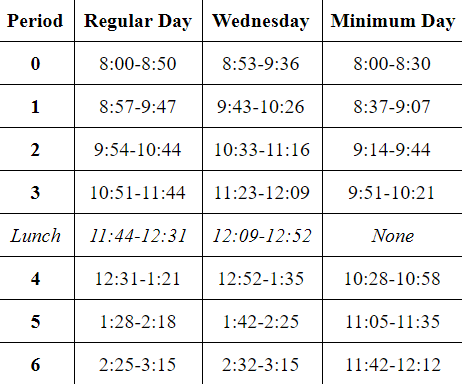
It’s around noon, and the bell rings.
On normal schools days, it would be lunchtime. However, on March 16, it’s the end of school.
These shortened days are known as minimum days, when class periods are 30 minutes long, meaning that school ends at 12:12 p.m.

These are the bell schedules for regular school days, Wednesdays, and minimum days.
“Usually, we have a minimum day after we have to stay late the previous day, like Back to School Night or Open House. Those days are long and tiring days for teachers so having a minimum day the next day is good for us,” Michal Nozik, a biology and chemistry teacher, said.
Since Open House was on March 15, the following day was a minimum day.
“I like minimum days because it’s not as much school work, so there isn’t as much stress. Also, I like to get home early and either play video games, eat, or sleep,” Zac Mallet, a sophomore, said.
However, this may not be true for all students. Getting home early can be advantageous, but the school day could seem rushed.
“I think people may not like minimum days because they don’t like shorter class periods because they have to rush to learn in the shortened time,” Mallet said.
For sophomore Taylor Meeks, minimum days are hard because of the increased workload due to the short classes.
“It’s hard because we have a lot of homework since the teachers don’t have enough time to fully teach the lesson,” Meeks said.
While some teachers have this problem, other teachers plan ahead of time to accommodate the shortened class.
“I have to plan and make sure that I’m planning something that can be accomplished in the short amount of time,” Nozik said.
Although minimum days have their advantages, a lot of them wouldn’t be beneficial according to Nozik.
“It’s not ideal to have a lot of minimum days because the periods are a lot shorter, so we don’t get a lot of time to teach,” Nozik said. “But I like minimum days [occasionally] because we get out sooner and it’s nice to rest after the long day before.”


